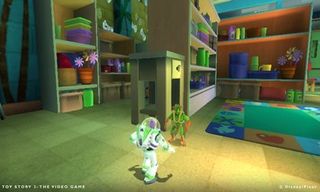12DOVE Verdict
Pros
- +
Confident platforming
- +
Pixar eye-candy
- +
Toy Box mode is really fun
Cons
- -
"Shake to attack" command needs to die
- -
Repetitive collect 'em all missions
- -
Checkpoints can throw you back a long way
Why you can trust 12DOVE
Toy Story 3 doesn’t introduce you to the characters, or catch you up to speed. Instead of starting the game in a tutorial, you assume Woody’s position jumping from train car to train car, while fighting off Evil Dr. Porkchop’s alien henchmen. Controls are simple enough, with buttons allotted to jump, hold Z to ender aiming mode, and the cursed “shake to attack” command. Besides that, the only help you’ll get are hints scattered around the level in little toy machine capsules. You don’t have to pick them up or ever see what they have to say. It’s a breath of fresh air in the three-hour tutorial kind of world we live in.

Once the first level is completed, players are teleported to a gameboard where missions are selected. From there, you can select the central campaign, the Toy Shop (where you spend coins found around the levels), or the Toy Box.
The Toy Box introduces a sandbox environment where players can enjoy less linear gameplay than the campaign offers. You can build up a town and fill it with residents and items, and apply custom paint schemes. Each new addition to your town adds new quests and each new quest unlocks new objects. The Toy Box truly is the heart of the game, but it won’t last long, especially without the unlockable objects you can only find within the campaign.
The campaign offers a haphazard take on the movie; it’s barely cohesive if you’ve seen the movie and completely disorienting if you haven’t. Certain sections that have been added from the original movie, like playtime at the imaginative Bonnie’s house, represent opportunities to inject crazy action levels not offered by the third film’s plot. In Bonnie’s house, Woody grinds rails in outer space a la Jet Set Radio Future while a wild witch shoots Poison magic at him. It’s actually quite fun.

Combat in the game is so simple and easy that many adult players will be wildly underwhelmed. However, platforming is so difficult that children will either be completely frustrated by it or simply unable to complete the game. This poses one of the greatest problems of Toy Story 3: it’s never quite sure who its target demographic is.
When puzzles get too difficult, hitting the right shoulder button displays a hint. If you fall from a cliff too many times, the game might provide you with a different, sturdier ledge. Unfortunately, it’s not enough help to guide younger kids through the often brutal platforming sections. It makes for good controller passing, though it might be unnecessary; certain levels allow two players to work cooperatively through the campaign. Graphics are distinctly Pixar-esque, though the colors on the Wii version are a tad less vibrant and everything looks a bit washed out.

Toy Story isn’t just a game for kids; fans of the trilogy should have no reservations about picking this one up.
Jun 24, 2010
More info
| Genre | Children's |
| Description | Toy Story isn’t just a game for kids; fans of the trilogy should have no reservations about picking this one up. |
| Platform | "Xbox 360","PS3","Wii","PC","PSP","DS" |
| US censor rating | "Everyone 10+","Everyone 10+","Everyone 10+","Everyone 10+","Everyone 10+","Everyone 10+" |
| UK censor rating | "","","","","","" |
| Release date | 1 January 1970 (US), 1 January 1970 (UK) |

New body horror movie starring real-life couple Dave Franco and Alison Brie lands a perfect Rotten Tomatoes score – as first reviews call it "weird" and "unhinged"

Wuchang Fallen Feathers wants to pick up where Dark Souls left off: "If skilled players still rely on the HUD... the combat system has a significant problem"

Roblox Anime Defenders codes (Jan 2025) for Gems and more
